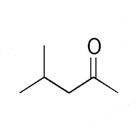What is Methyl Iso Butyl Ketone?
Methyl iso butyl ketone (also known as MIBK, methyl isobutyl ketone, and mono-iso butyl ketone) is a clear, colourless liquid with a characteristic ketone odour. It has the chemical formula C6H12 and is slightly soluble in water and is miscible with most organic solvents.

How is Methyl Iso Butyl Ketone produced?
There are two main routes for MIBK production. In the first, MIBK is produced from isopropanol in a mixed ketones process. Di isobutyl ketone (DIBK) and acetone are co-products of this process. In the second, MIBK is produced from acetone with hydrogen by a 3 step process of aldol condensation, dehydration, and hydrogenation.
At present, the global production capacity for MIBK stands at 370,000 tonnes per year.
Storage and Distribution of Methyl Iso Butyl Ketone
MIBK is stored in drums and/or in bulk tanks and is transported by tank trucks. It has a specific gravity of 0.802 and a low flash point of 16° C (closed cup) which makes it highly flammable. It should, therefore, be stored in a cool, dry, well-ventilated area that is free from the risk of ignition. For transportation purposes, MIBK is classified as packing group II, hazard class 3, and is an irritant.
What is Methyl Iso Butyl Ketone used for?
MIBK is an excellent solvent and 64 % of the total global MIBK produced is consumed in this way. It is primarily used as a solvent in cellulose-based and resin-based coatings and adhesives. It is also an extraction solvent for antibiotics and other pharmaceuticals, and is employed in rare-metal extraction as a solvent for metal separation.
MIBK is also a chemical intermediate that is used to produce target molecules such as rubber antiozonants (used in the production of tyres) and acetylenic diol compounds.



